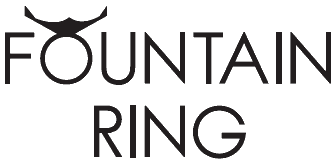Story behind the development
Fountain Ring Movie, made in 2015 August.
You can choose Italian or English Annotation here in Youtube.

The beginning of the development
I started my career when I was twenty years old, during my third year at Musashino Art University. One day, while I was washing a spoon, I noticed that tap water created a thin and transparent membrane when hitting the surface of the spoon. I also realized that this phenomenon created a dry area beneath the water membrane where my hand wouldn’t get wet. I was enchanted by this sudden discovery. I started dreaming about building a water dome that could cover my whole body.

At first, I studied the six elements of a water membrane. Then, using many water pumps, I researched the mutual relationship between the water flow and the membrane’s diameter.

As you can see, a 20cm water dome looks like a jellyfish. A 70cm one can be worn as headpiece, stimulating the five senses. The dry space under the water dome is limited to a diameter of about 2m. So, when I created a 8m water dome, the size of the dry space remained the same. In this case, the surface created by the running water is suitable for projection mapping. Visitors could enjoy the feeling of being underwater and at the same time watch the projected lights.
With my water dome project titled “Study of an immersive water display” I obtained my PhD at Tokyo University. My dream became to celebrate the importance of water with everyone, beyond countries and borders.
Big Fountains Era
From 1999 to 2009, I built 11 water domes at Japanese museums, department stores and rock festivals as temporary installations. Constructing and dismantling each water dome took 6 hours. The system is made of a pool, a water pump and pipes and a circular platform. In addition, electricity is needed for the circulation of the 13 tons of water needed to make the installation work and to provide energy to the lighting equipment.


From 1999 to 2009, I built 11 water domes at Japanese museums, department stores and rock festivals as temporary installations. Constructing and dismantling each water dome took 6 hours. The system is made of a pool, a water pump and pipes and a circular platform. In addition, electricity is needed for the circulation of the 13 tons of water needed to make the installation work and to provide energy to the lighting equipment.
At times I was asked if I could build larger water domes. The answer was yes, but the space where people could stand under the running water without getting wet would still remain the same size.
I was really happy to be able make water domes, but, at the same time, I felt frustrated, because the quality of the entertainment didn’t always match up to my expectations. To make the water domes more enjoyable, I needed more water, fire, lasers and fireworks, but that wasn’t always possible. I also couldn’t built water domes whenever I wanted to, despite having designed them.

Small but beautiful Fountains
So I was determined to develop a small but beautiful fountain. As you know, my starting point was in the kitchen. I designed silver spoke but it generated three antennas of water flow.



Back to the basics, I studied many types of shapes and finally developed five special ones: a butterfly, a spider, a dragonfly, a cherry blossom and an arabesque.
Thanks to my research, in 2013 Atelier OPA was awarded with the Lexus Design Award. During that time, I turned two of those particular shapes into finger rings.
Paola Antonelli, one of the judges and a senior curator of The Museum of Modern Art (MoMA) commented “Poetic, effective, minimum effort > maximum effect. It chooses delight as a goal and it achieves it.”
3D Modeling
Rapid prototyping helped me with finalizing the details. After drawing the shapes, our designer, Ishikawa turned them into 3D models.
Each time the model is completed we produce it by using a 3D printer and check the result under running tap water, making small changes as we go. Finally, I was able to obtain a final design.

After that I first worked with a wax model, which I later used to create a silver one. Lastly, a craftsman polished it and turned it into the final product. All these procedures were done in Tokyo, making Fountain Ring a product 100% made in Japan. These rings are the product of twenty years of research. I have also applied for Japan, US, EU and Chinese design patents.
We launched crowdfunding project on August 2015. After two months, 40 collectors ordered Fountain rings for one self, their family and boyfriend or girlfriends. Many husbands chose this ring for his wife without hesitation, because it is not only romantic gift, but also it attracted the giver’s themselves. We carefully produced the rings and sent before Christmas.

In 2016, we updates some details and started to sell Fountain rings officially. In April, we released brand new Fountain ring with jewelry which indicates the spot to hit the water. It became easier to make beautiful butterfly fountain with this mark. I hope these rings bring you the happiness and surprise too.

